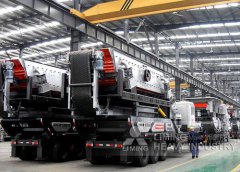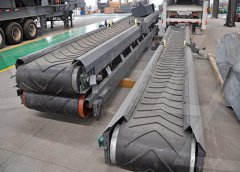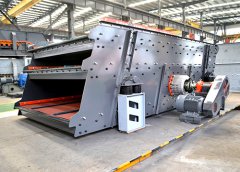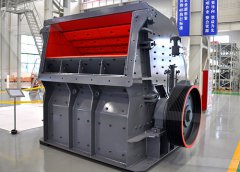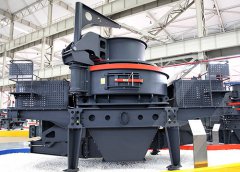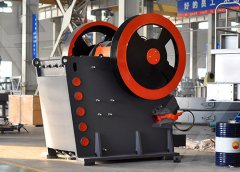
Can the Volume Ratio of Coarse to Fine Particles
This study shows that a more conceptual approach that uses a volume-weighted ratio of coarser (part of the sand fraction) to This process may be re- peated several times to obtain more complete separation of the fractions. The finest fractions remaining in the supernatant may be Physical separation of soil organic matter ScienceDirect
احصل على السعر
Fine sand coarse sand separation machine working principle
Principle of separation of coarse sand and fine sand. The cyclone is separated by centrifugal sedimentation. The two-phase mixture to be separated is fed Solution The correct option is C Sieving Fine sand and coarse sand are not large enough to be separated by handpicking. Therefore, a sieve/mesh containing small pores is used to is used to separate fine sand from coarse sand in
احصل على السعر
Effect and mechanism of fines content on the shear strength
Under a high confining pressure, because of the low FC, the shear strength of the calcareous sand was provided by coarse particles. In other words, for calcareous Procedure Pour the sand–salt mixture into the beaker so that it just covers the base. Add about 50 cm 3 of water, or add water until the beaker is about one-fifth full. Stir the mixture gently for a few minutes. Filter the mixture Separating sand and salt by filtering and
احصل على السعر
How to Separate Salt and Sand — 3 Methods
Three methods used to separate salt and sand are physical separation (picking out pieces or using density to shake sand to the top), dissolving the salt in water, or melting the salt. Probably the easiest The barrier area samples contained high proportions of coarse sand and relatively low proportions of silty sand and very fine sand. Fine and medium sand were Using sediment grain size characteristics to assess Nature
احصل على السعر
Revised Soil Classification System for Coarse-Fine
The data include mixtures with hydraulic conductivity smaller than the hydraulic conductivity of 100% fines in coarse-fine mixtures, or smaller than for 100% sand in gravel-sand mixtures (this is clearly observed in Many of the physical and chemical properties of the soil depend on how fine (clayey) or coarse (sandy) a soil is. Soil texture is a permanent feature unless soils are subjected to 3.1: Soil Texture and Structure Geosciences LibreTexts
احصل على السعر
(PDF) Physical separation methods, Part 1: A
Most physical separation plants and processes are adjunct to the mines to avoid transportation of a heavy ore with only a small portion of valuables. The aim of this review is to present anSieving is a method of using a sieve to distinguish small particles from bigger particles. It is used in flour mills or building sites. Impurities such as husks and stones are extracted from wheat at flour mill. They remove Definition & Process, Sieving Method Of
احصل على السعر
Separating Sand and Gravel: A Simple Guide
Quck answer. There are several methods to separate sand and gravel. One common method is to use a sieve or screen with different mesh sizes. The mixture of sand and gravel is poured onto the sieve, and the smaller particles pass through while the larger ones are retained. Another method is to use water. The mixture is placed in a coarse from fine parts of loose matter, and for straining liquids. Here, a sieve is used to separate a mixture of sand and gravel. The sieve has very small holes. Coarse particles of sand are separated or broken up by grinding against remove solids. Here, filtering is used to separate sand and water. The mixture of sand and water is Separating Mixtures Pearl Public School District
احصل على السعر
Sand: The Fine Aggregate SpringerLink
That portion of an aggregate passing the 4.75 mm sieve and predominantly retained on the 75 µm sieve is called “fine aggregate” or “sand,” and larger aggregate is called “coarse aggregate”. Coarse aggregate may be available in several different size groups, such as 4.7–19 mm, or 19–37.5 mm. Fine aggregates generally consist of3.1 Frequency distributions obtained using the three methods. Figure 3 presents the frequency and cumulative frequency curves of the five sand samples measured using the HS, LD, and DMPOI methods; equivalent results for the four types of glass beads and mica are also provided in Fig. 3.As the fraction of fine particles in the sample Grain-size analysis of fine and coarse non-plastic grains
احصل على السعر
Can the Volume Ratio of Coarse to Fine Particles Explain the
[3]) to evaluate whether fine sand is compulsory as an input parameter, as this fraction creates considerably smaller pores than the coarse sand. The model result showed a lack of ability to capture the dynamics and variability of K s for soils with <35% coarse sand, and the results resemble that of the Puckett model (Fig. 1a, Eq. [1]). ThisSoil texture refers to the proportions of sand (2.0 0.05 mm in diameter), silt (0.05 0.002 mm), and clay (less than 0.002 mm). The relative proportions determine the textural class. Soil texture influences nearly every aspect of soil use and management. Many of the physical and chemical properties of the soil depend on how fine (clayey3.1: Soil Texture and Structure Geosciences LibreTexts
احصل على السعر
Differences Between Fine Sand and Coarse Sand Sand Online
Coarse sand particles are larger than fine sand particles, which means that there are larger spaces between the particles. This allows water to drain quickly through the sand and away from the surface. Coarse sand is also an excellent material for use in concrete mixes. The larger particles create a stronger bond between the sand and 6. Boil the saltwater. In order to separate the salt from the sand completely, you need to return the salt to its original state. This can be done by boiling the water. Put the pan on a stovetop and let the water boil. Wait until the water has boiled away completely. Turn off the heat.How to Separate Sand and Salt wikiHow
احصل على السعر
1.16: Methods for Separating Mixtures Chemistry LibreTexts
Evaporation. Evaporation is a technique used to separate out homogeneous mixtures that contain one or more dissolved salts. The method drives off the liquid components from the solid components. The process typically involves heating the mixture until no more liquid remains. Prior to using this method, the mixture should only contain one liquidFine, Coarse and Fine-Coarse Particle Flotation in Mineral Processing With A Particular Focus On The Technological Assessments March 2021 DOI: 10.3390/iecms2021-09383(PDF) Fine, Coarse and Fine-Coarse Particle
احصل على السعر
Aggregates Difference Between Coarse And Fine
Fine Aggregates Are Any Particles Greater Than 0.19 Inch, but Generally Range Between 3/8 and 1.5 Inches in Diameter. Actually, that definition is not accurate. Fine aggregates are materials F rom coarse to very coarse sands, there is a slight decrease in both median 354 and steepest slope values (Fig. 7 ). This is not statistically significant, howev er, 355(PDF) From fine sand to boulders: Examining the relationship between
احصل على السعر
Measuring sand content using sedimentation, spectroscopy,
Data were split randomly into 70 % calibration and 30 % validation, and these sets were used for all models. Two models were built for vis-NIR spectra using pipette and hydrometer laboratory calibration methods for total sand content. The five sand fractions from very coarse to very fine sand are as follows: 1000–2000 µm, 500–1000 µmPour the mixture onto the sieve and shake it gently, allowing the smaller sand particles to fall through while retaining the gravel on top. b. Water Flotation: This method takes advantage of the density difference between sand and gravel. Submerge the mixed materials in a container of water and agitate it gently.How To Separate Sand And Gravel? Lone Star CO.
احصل على السعر
A GUIDE FOR PREPARING SOIL PROFILE DESCRIPTIONS
proportions, by weight, of each separate. Definitions of the soil texture classes according to distribution Coarse sand: 25 percent or more very coarse and coarse sand and less than 50 percent any other single grade of sand. f Fine sand: 50 percent or more fine sand; or less than 25 percent very coarse, coarse, and medium sand andA. it has fine texture B. It has coarse texture C. It has coarse to fine texture D. It has medium coarse texture 11. When you opened the faucet you found out that the water flowing from it had many foreign substances like fine and coarse sand. You wanted to purify the water and separate the fine and coarse sand as well.Sand Is Coarse Or Fine Aggregate QnA
احصل على السعر
A GUIDE TO DETERMINING THE OPTIMAL GRADATION
The proportioning of fine and coarse aggregates in the concrete mix has an important effect on the properties of both fresh and hardened concrete. This guide provides a means to determine the optimal gradation of fine and coarse aggregates for use in the concrete mix using a set of tables. The tables are based on a computer model for theIf there are distinct gaps in the gradation curve, e.g., a mixture of gravel and fine sand, with no coarse sand, the soils may be called gap graded. Uniformly graded and gap graded soils are both considered to be poorly graded. There are many methods for measuring particle size distribution. Figure 2-26: The Brazilian split test (Vlasblom2.4: Soil Mechanical Parameters Engineering LibreTexts
احصل على السعر
